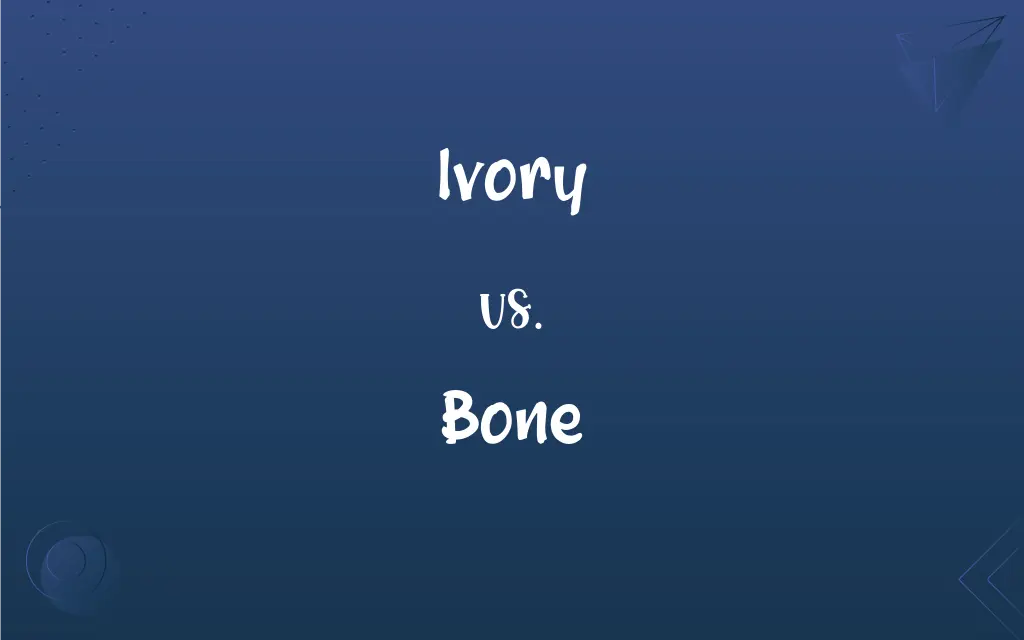Ivory vs. Bone: What's the Difference?
Edited by Janet White || By Harlon Moss || Updated on October 17, 2023
Ivory is dense, hard, white material from tusks and teeth of animals, while bone is a rigid organ forming a skeleton.

Key Differences
Ivory, sourced primarily from the tusks of elephants and the teeth of certain other mammals, is known for its fine texture, durability, and creamy white color. In contrast, bone, which makes up the skeletons of most vertebrates, has a more porous structure and is generally off-white.
The use of ivory has been prized throughout history for art and decorative items due to its smoothness and the ease with which it can be carved. Bone, while also used in crafting, is more commonly associated with practical tools or utensils, and lacks the premium status of ivory due to its more common occurrence and different aesthetic qualities.
Ivory's extraction, often linked to the endangerment of species, particularly elephants, has led to international bans and significant ethical concerns. However, bone, usually harvested from animals that are used for a variety of other purposes (like food), does not generally involve the same ethical implications, except in cases of endangered species.
When it comes to authenticity verification, ivory tends to be denser and has a specific crosshatch pattern, known as Schreger lines, visible in cross-section. Bone, however, shows a more porous, less dense structure under similar examination, which helps in distinguishing between the two materials.
In terms of maintenance, ivory, being more sensitive to environmental conditions, can crack or discolor over time and requires careful preservation. Bone is also susceptible to damage over time but is generally more resilient to environmental changes compared to ivory.
ADVERTISEMENT
Comparison Chart
Composition
Denser, smooth, from tusks/teeth
More porous, from skeletal structures
Usage
Luxury art, decor
Tools, utensils, less decorative art
Ethical Concern
High (endangered species)
Lower (common animals)
Identification
Schreger lines, denser
Porous, less dense
Maintenance
Sensitive to environment, needs preservation
More resilient, still requires care
ADVERTISEMENT
Ivory and Bone Definitions
Ivory
A color name for a shade of creamy white.
She chose an ivory dress which perfectly matched the vintage theme.
Bone
A piece of a skeleton symbolizing mortality in literature/art.
Skulls and bones in art often represent the transience of life.
Ivory
Hard white material from tusks and teeth of mammals.
The antique shop displayed a carved ivory statue from the 19th century.
Bone
A term used in phrases to indicate sincerity or hard work (e.g., "to the bone").
She was chilled to the bone during the winter trek.
Ivory
A material historically prized for its carving potential.
Artisans chose ivory for its malleable yet durable nature.
Bone
The rigid organs composing the skeleton of vertebrates.
The museum displayed the bone structure of a prehistoric animal.
Ivory
A term linked with elephant conservation due to poaching.
Ivory trade bans are crucial in the efforts to save elephants from extinction.
Bone
A material used in crafting, from tools to ornaments.
The artisan carved intricate designs into the bone to create jewelry.
Ivory
A substance used in piano keys and billiard balls historically.
The old piano had keys of genuine ivory, a feature not seen in modern instruments.
Bone
A classic dog's chew toy or treat.
He gave his dog a bone to keep her busy while he was cooking.
Ivory
A hard, smooth, yellowish-white substance composed primarily of dentin that forms the tusks of the elephant.
Bone
The dense, semirigid, porous, calcified connective tissue forming the major portion of the skeleton of most vertebrates. It consists of a dense organic matrix and an inorganic, mineral component.
Ivory
A similar substance forming the tusks or teeth of certain other mammals, such as the walrus.
Bone
Any of numerous anatomically distinct structures making up the skeleton of a vertebrate animal. There are more than 200 different bones in the human body.
FAQs
What is bone made of?
Bone is made of a mix of collagen and calcium phosphate.
Why is ivory considered valuable?
Ivory's value comes from its rarity, texture, and historical significance in art and culture.
Is all ivory trade illegal?
Most international ivory trade is illegal, but some pre-ban antiques and certain exceptions exist.
What animals does ivory come from?
Ivory is primarily sourced from elephant tusks but also from other mammals like walruses and narwhals.
How can you tell real ivory from fake?
Real ivory has a unique pattern called Schreger lines, not seen in synthetic or other natural imitations.
Are bones stronger than steel?
In certain ways, yes - bones are pound-for-pound stronger than steel when it comes to supporting weight.
What's the most commonly broken bone in the human body?
The clavicle or collarbone is one of the most frequently broken bones.
Can bones regenerate or heal?
Yes, bones have the natural ability to heal and regenerate, but the process depends on factors like age and health.
How long does it take for a bone to heal?
Bone healing varies, typically taking several weeks to months, depending on the bone and injury severity.
What nutrients are good for bone health?
Calcium and vitamin D are crucial for maintaining strong bones.
Why is ivory poaching a problem?
Ivory poaching threatens elephant populations and involves illegal trade, violence, and corruption.
What happens if a bone doesn't heal properly?
Improperly healed bones can result in deformities, limited mobility, or chronic pain.
What's being done to prevent ivory trafficking?
Measures include international trade bans, law enforcement, and public awareness campaigns.
How do bones contribute to overall health?
Bones provide structure, protect organs, anchor muscles, and store calcium.
Do human bones weaken with age?
Yes, bones typically lose density and strength with age, a condition known as osteoporosis.
Can ivory change color over time?
Yes, ivory can yellow with age due to exposure to light and environmental conditions.
Can you donate bone marrow?
Yes, bone marrow donation is a medical procedure to help those with certain diseases, like leukemia.
What's the significance of ivory in piano keys?
Historically, ivory was used for its smooth texture and aesthetic appeal on piano keys, though it's no longer common.
Are there alternatives to ivory?
Yes, alternatives include synthetic materials, vegetable ivory, and other natural materials like bone or horn.
How did ancient cultures use ivory?
Ancient cultures used ivory in art, religious items, jewelry, and tools, valuing it for its carvability and beauty.
About Author
Written by
Harlon MossHarlon is a seasoned quality moderator and accomplished content writer for Difference Wiki. An alumnus of the prestigious University of California, he earned his degree in Computer Science. Leveraging his academic background, Harlon brings a meticulous and informed perspective to his work, ensuring content accuracy and excellence.
Edited by
Janet WhiteJanet White has been an esteemed writer and blogger for Difference Wiki. Holding a Master's degree in Science and Medical Journalism from the prestigious Boston University, she has consistently demonstrated her expertise and passion for her field. When she's not immersed in her work, Janet relishes her time exercising, delving into a good book, and cherishing moments with friends and family.































































